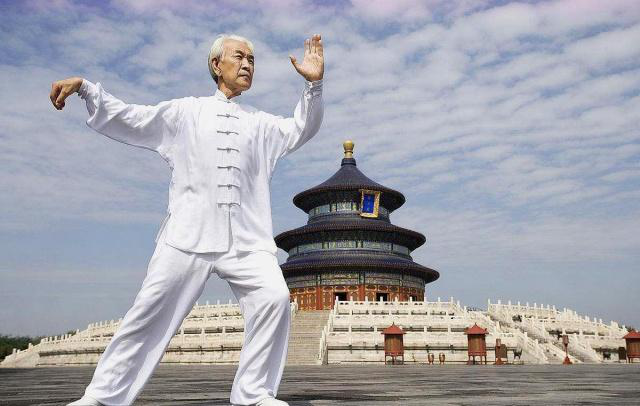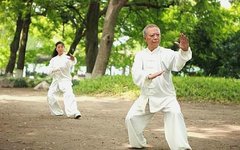
Qigong is a sports discipline rich in national characteristics, with a long history and cultural heritage spanning thousands of years. To understand the basics of Qigong, one must know what Qigong is, which includes various forms such as Fitness Qigong, Tai Chi Qigong, and Health Preservation Qigong. Let’s explore this together.

Fitness Qigong
Fitness Qigong combines fitness and Qigong, primarily focusing on physical exercise aimed at enhancing physical fitness.
Long-term mental unhappiness or tension can lead to various bodily changes. These somatic changes induced by psychological factors are termed psychosomatic diseases in psychosomatic medicine. Qigong practice can strengthen this mechanism, thus serving to prevent diseases and treat bodily changes.
To achieve good results in Qigong practice, practitioners must reach a state of tranquility. This so-called tranquil state involves the practitioner utilizing their conscious agency to relax both body and mind, eliminating distractions, and gradually transitioning from a state of wakefulness to a state that is neither fully asleep nor fully awake.
Eliminating distractions and maintaining a proper mindset primarily require self-regulation, bringing the body into a peaceful state.
Popular Types
Currently, there are nine main types of popular Fitness Qigong:
Yi Jin Jing (Muscle-Tendon Change Classic), Wu Qin Xi (Five Animal Frolics), Competitive Fitness Qigong, Liu Zi Jue (Six Healing Sounds), Ba Duan Jin (Eight Pieces of Brocade), Shi Er Duan Jin (Twelve Sections of Brocade), Da Wu (Great Dance), Dao Yin Yang Sheng Gong Shi Er Fa (Twelve Methods of Health Preservation), Ma Wang Dui Dao Yin Shu (Mawangdui Health Preservation Techniques), Tai Chi Health Stick.

Health Preservation Qigong
Health Preservation Qigong is a method of physical and mental exercise guided by traditional Chinese medicine principles, utilizing specific techniques combined with breathing and intention to regulate the body and mind for health maintenance and disease prevention.
It is related to modern preventive medicine, psychosomatic medicine, sports medicine, natural medicine, geriatric medicine, as well as physical education and martial arts. It adjusts the activities of internal organs through self-regulation of intention, breathing, and body, thereby enhancing the body’s stability mechanisms to achieve the goal of disease prevention and longevity.
To understand what one should do to start practicing Qigong, it is essential to first recognize its benefits. However, like all things, there are two sides to it. Therefore, practicing Qigong can also lead to imbalances. Below are some benefits of practicing Qigong.
Benefits of Practicing Qigong
“Treating illness when sick, strengthening the body when healthy” is a summary of the effects of Qigong by ancient practitioners. In recent years, with the widespread dissemination of Qigong, millions of practitioners have further confirmed the ancient summary of Qigong’s role in disease prevention and treatment. Below are some benefits of practicing Qigong for healthy individuals.
1. Preventive Health Care
The Huangdi Neijing (Yellow Emperor’s Inner Canon) states, “When the righteous qi is preserved within, evil cannot invade,” and “When the spirit is kept within, where does illness come from?” This indicates that practicing Qigong has the effect of preventing diseases and promoting health.
Modern research has proven that practicing Qigong significantly alleviates psychosomatic fatigue, restores physical strength and energy, improves work efficiency, enhances immune function, and prevents diseases. As society develops, the pace of daily life becomes faster, and psychological tension increases.
Long-term psychological tension can lower the body’s immunity, disrupt physiological functions, and lead to functional or even organic changes. Therefore, learning to relax appropriately amidst a tense rhythm is essential for fitness and disease prevention.
Qigong practice effectively fulfills this role. Evidence shows that those who practice regularly do not easily become fatigued, often feel energetic, and rarely suffer from colds and other illnesses.
2. Cultivating Character
Traditional Chinese Qigong emphasizes that practice should cultivate the heart and nurture the character, optimizing emotions, will, and personality. This is both a prerequisite for achieving good results in practice and a direct benefit gained through Qigong training.
Experience tells us that individuals in a tranquil state during Qigong practice experience great pleasure and comfort, not only physically but also emotionally, immersing themselves in a transcendent state. Long-term adherence to Qigong practice can cultivate character, broaden the mind, strengthen willpower, shape a well-rounded personality, and enhance psychological adaptability.
Practicing Qigong also makes tasks feel more manageable, increases efficiency, and improves interpersonal relationships, thereby enhancing mental health.
3. Developing Intelligence
Qigong practice can develop intelligence, a point clearly discussed in ancient Qigong texts. With deeper research into Qigong, this effect has been gradually confirmed.
Through Qigong practice, brain fatigue can be quickly alleviated, leading to increased energy, focused attention, heightened sensory perception, improved memory, and enhanced cognitive abilities, thereby raising intelligence levels. Experts believe that Qigong may become an effective means of enhancing human intelligence.
4. Longevity
Traditional Chinese medicine holds that as people age, yin essence becomes deficient, and true essence gradually declines, leading to a gradual decrease in bodily functions. Some individuals may also experience premature aging due to various reasons. Practice has proven that Qigong can mobilize and utilize the body’s inherent potential, delaying or preventing aging, combating cognitive decline in the elderly, and promoting the physical and mental health of older adults, thus achieving longevity.
Additionally, Qigong can be widely applied in various fields such as calligraphy, painting, dance, athletics, music performance, and acrobatics training, helping practitioners enhance psychological stability, eliminate tension, mobilize physiological potential, and improve the efficiency of their activities.
Content and images sourced from the internet. If there are any copyright issues, please contact the editor.
Submitted by: Group Science
Editor: Ma Hui







